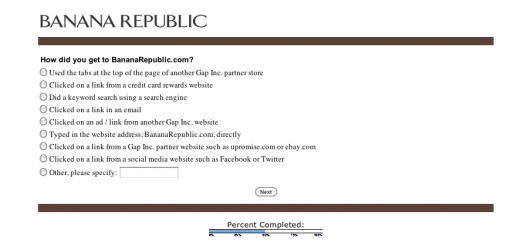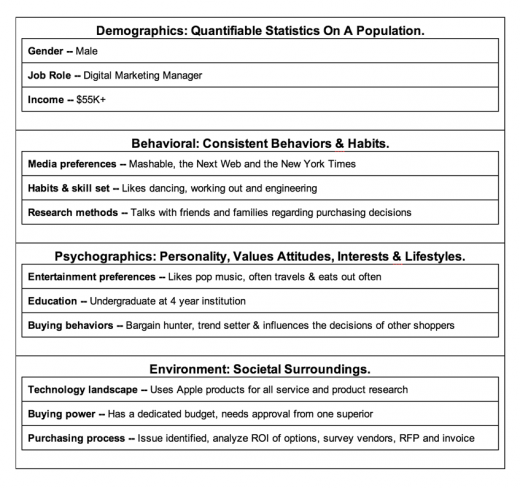
Brian Honigman is a marketing consultant, a professional speaker and a freelance writer. This post originally appeared on the SumAll blog.
One of the most important parts of your business is understanding who your customer is. This helps define what makes your company unique as compared to other businesses in your industry. The notion of a brand is created around these differentiators helping define what makes one company that different than the next.
Customers choose to shop at one t-shirt store over another or eat at one taco place over the other because you’ve built a business that caters to a particular demographic, offering quality products or services at the right price based on your market.
Therefore, it’s very important, especially from a marketing perspective, to know how to create an accurate customer profile that helps define who the customer is that you’re trying to reach.
1. Understand your own products and services, their intended use, and the way they’re actually being used
To begin crafting an accurate customer profile, fully understand your own products, services, and your mission as an organization. This is an ongoing process, but from the very beginning it’s essential to understand who you want your customer to be and how that relates to how your products and services are developed and packaged.
The use of your offerings affects what type of people decide to use them and therefore, must be monitored accordingly to ensure your products and services are of the highest value to that audience. For instance, if your company is a clothing store, the way the jeans or t-shirts you sell fit a customer can greatly affect what type of customer your business attracts.
Taking note of these differences in the details of your products and services, as well as how they are used is important to ensure you’re consistently crafting the right experience for your customer base.
By paying attention to the use of your products and services, you’ll be able to see how your customer’s use of your offerings changes overtime and how your organization should respond to these changes. This could mean your business shifts around your offerings to better suit your customer’s needs, your team decides to build an additional product or service to address this change etc.
Lastly, the mission of an organization also helps define how a brand is presented and what type of customers do business with your company.
For instance, if your company believes in ensuring eco-friendly practices or giving back a percentage of profits to charity, these activities could impact the type of customer your business attracts. Keep this in mind when building a profile of the customer you’re trying to reach, altering your mission to match their needs and interests.
2. Seek ongoing feedback from customers, alongside industry research
As accurate of a profile you have of your customer and as much as your company actively adapts its offerings to their needs, the customer is in control – today more than ever. In order to understand what they want from your business and the industry as a whole, ask them.
To have the most accurate customer profile as possible, survey your audience consistently to get their feedback on your offerings as well as their perception of your company. Tools like Survey Monkey, Checkbox or Survata are helpful and affordable for business of all sizes looking to survey their audience.
Using your existing email list or social media accounts, ask your customers about your company, about themselves, their preferences, the marketplace at large and more in a few easy to answer questions that will help your company better understand what your customer base is really like. 
Sometimes it may be difficult to get your customers to take part, which is why incentivizing them to participate with a coupon or promo code for a discount is a great way to encourage them participate. Make sure regardless of how you’re requesting feedback from your audience that you make the process enjoyable.
Lastly, gain insights from your customer base by reviewing reports on the landscape of your industry from sources like eMarketer, L2 or Forrester, among others. Organizations like these are tasked with analyzing trends in customer behavior across different verticals that among many things can help your business keep an accurate profile of your customer, despite the consistent changes amongst their behaviors overtime.
3. Map out the interests of this customer based on demographics, psychographics, behavioral and environment including age, interests, job role, gender, location and more
From both your predictions of who your customer is as well as actual data on your existing customer base, create a map of their interests based on different demographics that make up the different ideal buyers. Every company has a few different types of customers and this map will clarify the differences between the profiles of each ideal buyer.
Explore what is unique about their individual preferences and write it all down to discuss what makes the list and what is removed. Map out the age, interests, job role, favorite music, gender, location, socioeconomic status, religious background, education level, race, ethnicity, income level and more.
Here’s an example of a very simple customer profile to help direct your strategy.

Ask questions like:
- What other businesses do they frequent?
- What websites do they tend to visit the most?
- What blogs do they regularly read?
- What are their personal interests?
- What type of job do they have?
- How does your product improve their life?
- How do your customers entertain themselves?
By asking the above questions and more, you’ll be able to tap into how your team collectively views your customer and once these aspects of your profile are mapped out, you’ll be ready to develop a strategy to consistently reach these customers.
4. Keep consistency across the company in terms of your customer profile
Once you’ve established who your customer is amongst your team in writing, require buy-in from all stakeholders in the company. Everyone must agree on the goals of your organization and the customer profile is critical tool for helping your business achieve those goals.
By requiring the customer profile be documented, easily accessible and agreed upon by all the members of your team, you’re ensuring consistency across the company. Consistency is important for the long-term success of your customer growth because each member of your team needs to be working towards the same goals in order to achieve them, otherwise your teams efforts could be fragmented and counter productive.
To ensure consistency, follow a template when creating and updating your customer profiles across the company. For example of what this template could look like, feel free to use our template below.
5. Revisit profile to account for evolution of your company, the industry and the consumer landscape
It’s important to note that the customer profile will always change since your business is in constant state of evolution because your customer’s shifting habits, interests and preferences.
Therefore, your company must continually update your customer profile once a quarter to make sure it’s still accurate based off of both your intuitions as an expert in your industry as well as data collected from reporting and customer feedback.
Consistently review industry reporting on your customer base and survey these customers once a quarter to gain new insights on changing habits, interests or preferences and update your customer profile accordingly. This will help your organization stay on track with your goals of driving more revenue and growing your customer base to the next level by accurately targeting people based on an accurate customer profile.
What’s stopping your business from creating an accurate customer profile? How is your company compiling accurate information about your ideal buyers? Let us know in the comments below.
Get the TNW newsletter
Get the most important tech news in your inbox each week.






